CEREC MC XL Milling Machine
CEREC MC XL – The ultimate in ‘extra fine’ grinding and milling in just a few minutes!
Read more Enquire nowCEREC MC XL – The ultimate in ‘extra fine’ grinding and milling in just a few minutes!
Read more Enquire now
The CEREC milling and grinding units and the CEREC software are optimally synchronised with one another. Grinding and milling the restoration design is extremely precise, giving the restorations smooth surfaces. Even very fine fissures are very precisely prepared and the edges are very even. Milling and grinding units can also dry mill, making solid zirconia restorations in a single visit possible!
The range of indications include inlays, onlays, crowns, veneers, bridges, abutments and drilling guides, as well as grinding of all practice laboratory indications with the CEREC MC XL Premium. It is also suitable for all CADCAM materials (plastic, ceramic and metal). Take advantage of the convenience of the 4 motors, optional ‘extra-fine’ grinding, and a user-friendly touchscreen.
The CEREC grinding and milling machines come with a vacuum cleaner for mill shavings and precision tools.
The CEREC MC XL can be used for both wet and dry processing. Dry milling saves a considerable amount of time because the restoration does not need to be dried before sintering, enabling the chairside procedure. There is also no difference in quality between dry and wet milling processes. The dry dust can easily be removed using a short, integrated cleaning programme.
Advantages of CEREC XL
The CEREC milling and grinding units and the CEREC software are optimally synchronised with one another. Grinding and milling the restoration design is extremely precise, giving the restorations smooth surfaces. Even very fine fissures are very precisely prepared and the edges are very even. Our new milling and grinding units can also dry mill, making solid zirconia restorations in a single visit possible!
CEREC grinding and milling units for a wide range of indications.
is how long it typically takes to grind/mill a single dental restoration, depending on the indication and material.
the precision provided by the CEREC milling units.
“Treatment often used to take a long time. With CEREC I got a complete crown in just one visit – without a temporary or follow-up visits. I call that service!”
Meike Tramitz, patient from Gießen
The new CEREC grinding and milling machines come equipped with a device to vacuum up the mill shavings as well as new precision tools. The new machine can be used for both wet and dry processing, one straight after the other. Dry milling saves a considerable amount of time, as the restoration does not need to be dried before sintering – thus enabling the chairside procedure. And there is no difference in quality between dry and wet milling processes. The dry dust can easily be removed using a short, integrated cleaning program.
CEREC MC XL – The ultimate in ‘extra fine’ grinding and milling in just a few minutes!
How to insert a block correctly into the MC XL Milling Unit
How to connect the radio module HW8614/F2 to the milling unit
Width 700 x Height 425 x Depth 420 (mm)
A MCXL unit achieves precise results and you only need approximately 11 minutes to create a crown.
Inlay/onlays, crowns, veneers, bridge frameworks, customised abutments, telescopes, bars, attachments and surgical guides can be fabricated.
The MCXL can create fully anatomical single tooth restorations up to a block size of 85mm.
No the unit has an integrated water tank and does not require compressed air.
Observe country-specific Regulations. Some countries have legal regulations which require regular safety inspections of electrical devices or systems by the operator.
Perform maintenance regularly. Have maintenance performed on your unit annually by trained technical personnel / a service engineer.
Observe error messages. You must observe error messages shown on the display. If the error message does not disappear even after you have performed the prompted action, contact our servicing team.
Once a week or after every forth water change:
Be aware chips gathered in the milling chamber
When milling models, a large number of chips collect in the milling chamber.
Each time a model block is milled, remove the chips from the milling chamber by hand.
Before removing them, squeeze the chips so that any stored water is released into the cooling circuit.
Do not confuse the block screw with the ball pressure screw
When operating a CEREC 3 milling unit and a CEREC MC XL Premium Package milling unit in the same room, be careful not to confuse the block screw of the CEREC 3 with the ball pressure screw of the CEREC MC XL Premium Package.
Using the tank cap opener
If you find the tank cap, tank drain or filter insert hard to open by hand, use the tank cap opener.
Wear of the ball pressure screw
The high clamping forces cause wear of the ball pressure screw.
Replace the ball pressure screw every 500 clamping operations.
Damage to the pump and milling drives
An excessively high ceramic and/or base metal content in the cooling water will damage the pump and milling drives. Change the water regularly.
When the water is due to be changed, a message window appears on your monitor to remind you that it is time to change the water.
Preventing odours
All milling additives contain a biologically degradable preservative. Despite this, however, odours may still develop under unfavourable conditions.
Observe the following:
Damage to surfaces
When undiluted, DENTATEC milling additive etches plastic surfaces and can cause discolouration.
Use only DENTATEC as a milling additive.
Change the filter inserts regularly.
Replace both filter inserts after every forth water change.
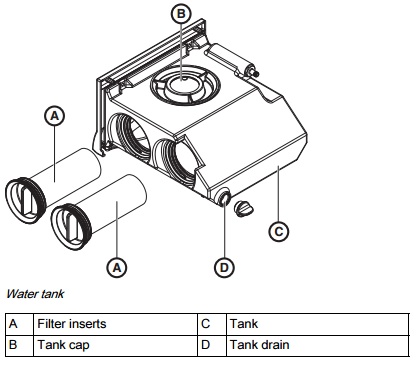
Procedure for all materials except for base metals
Foaming not permissible. If any cleaning agents are used, this will create foam, which is not permitted. Do not use any cleaning agents.
To change the water, make sure:
✔ The unit is switched on.
✔ No production/scanning process is running.
Then proceed as follows:
1. Pull out the water tank at the front of the unit.
2. Open the drain opening (D).
3. Empty two thirds of the water from the tank.
4. Close the drain opening (D).
5. Shake the tank vigorously.
6. Open the drain opening (D).
7. Drain the rest of the milling water.
8. Close the drain opening (D).
9. Turn the tank cap (B) counter-clockwise and take it off.
10. Add approx. 75 ml of DENTATEC to the tank.
11. Fill the tank with water until the filter inserts (A) are completely immersed (up to the bottom edge of the cover thread, approx. 3 litres).
12. Wait briefly until the filter inserts (A) are soaked full and add a corresponding amount of water.
13. Close the water tank by tightening the tank cap (B) clockwise by hand. Do not use the tank cap opener for this.
14. Push the water tank back into the housing.
Procedure for processing base metal materials
Observe the safety information from the material manufacturer.
Observe the safety instructions regarding occupational safety and disposal referred to in the material manufacturer's operating instructions.
Use a waterproof receptacle with a nominal volume of 10l as a collecting vessel for changing the water (e.g. a commercially available 10l plastic bucket). When selecting the collecting vessel, bear in mind that it will also serve as a transporting container for disposal and is not reusable.
Wearing protective waterproof gloves is recommended.
In mixed operation, the tank can be used with base metals and other materials. It is, however, recommended that you use an additional standard tank which is only used for processing base metal materials. Tank double filter with CS aperture, traffic white spare.
Ask your disposal company whether the filter waste needs to be correctly sorted for disposal.
Once the water has been changed, the collecting vessel will contain a mixture of base-metal slurry (in mixed operation, there will also be other materials) and water. The machining particles dispersed in the water will settle to the bottom of the collecting vessel within 24 hours, resulting in a clear separation between the water and the settled solid matter. The clear water can then be removed or siphoned off from the collecting vessel. The collecting vessel can be used until it is max. half-full of milling slurry (solid matter) or until the permitted weight for the collecting vessel used has been reached. 5l of correctly sorted base-metal machining waste corresponds to 40kg in weight depending on the basemetal alloy.
The external must not be used for processing base metal materials.
To empty the milling water and milling slurry, make sure:
✔ The unit is switched on.
✔ No milling process is running.
✔ A collecting vessel of approx. 10l is available.
Then proceed as follows:
1. Pull out the water tank at the front of the unit.
2. Pan the tank vigorously 5x in circular movements.
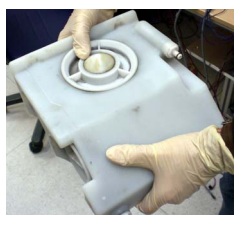
3. Open the drain opening (D). Tilt the tank so that no liquid escapes through the drain opening.
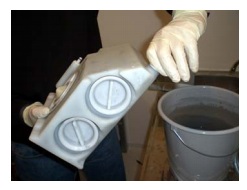
4. Close the drain opening (D) using your thumbs and pan the tank vigorously 5x in circular movements again.
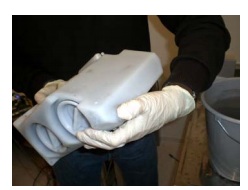
5. Empty approx. 1/3 of the contents of the tank into the collecting vessel provided. Operating the spring-loaded inlet opening of the tank cap (B) allows the contents to flow out easily.
6. Close the drain opening (D) using your thumbs and pan the tank vigorously 5x in circular movements again.
7. Empty approx. 1/2 of the remaining contents of the tank into the collecting vessel provided. Operating the spring-loaded inlet opening of the tank cap (B) allows the contents to flow out more easily.
8. Close the drain opening (D) using your thumbs and pan the tank vigorously 5x in circular movements again.
9. Empty the residual contents into the collecting vessel provided.
10. Close the drain opening (D) with the screw cap.
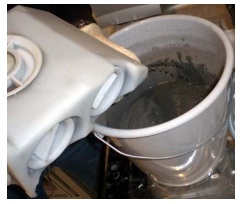
1. Turn the tank cap (B) counter-clockwise and take it off.
2. Fill the tank approx. 1/3 full with water.
3. Close the tank cap (B).
4. Open the drain opening (D). Tilt the tank so that no liquid escapes through the drain opening.
5. Close the drain opening (D) using your thumbs and pan the tank vigorously 5x in circular movements again.
6. Empty the residual contents into the collecting vessel provided.
7. Close the drain opening (D) with the screw cap.
1. Turn the tank cap (B) counter-clockwise and take it off.
2. Add approx. 75 ml of DENTATEC to the tank.
3. Fill the tank with water until the filter inserts are completely immersed (up to the bottom edge of the cover thread, approx. 3 litres).
4. Wait briefly until the filter inserts are soaked full and add a corresponding amount of water. This applies in particular after the filter has been changed.
5. Close the water tank by tightening the tank cap clockwise by hand. Do not use the tank cap opener for closing the tank cap.
6. Push the water tank back into the housing.
Instruments without chuck
In order to ensure that no grease residue from previously used chucks remains in the clamping cone when using instruments without a chuck, we strongly recommend degreasing the clamping cone.
Regular replacement of instruments
Change the instruments as soon as the system prompts you to do so. Change the instruments after using them to mill 25 restorations at the latest.
1. In the software, navigate to the system menu, and click on the "Configuration" button.
2. Click on the "Devices" button.
3. Click on the unit whose instruments you wish to replace.
4. Click on the "Change Instruments" button. If two sets are activated: A dialog box then opens where you can select the set, whose instruments should be replaced.
5. If necessary, select the desired set. You can also select the desired set on the touch display of the milling unit.
6. Click the "Start" button on the PC or touch display. The motors travel to the change position for the instruments. The dialog box for changing the instruments opens.
7. Press the catch of the milling chamber door and open the door.
Risk of injury on instruments
If you put your hand in the milling chamber, you could injure it on the instruments. Be careful not to brush against the instruments with your hand. Apply the torque wrench as shown.
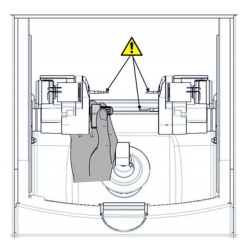
8. Loosen the worn-out or defective instrument with the torque wrench and pull it out manually.
Do not grease the instrument without chuck. Insert the new instrument into the motor mount by hand. Tighten the corresponding chuck with the torque wrench until a clicking sound can be heard.

Inaccurate production results: Interchanging instruments leads to faulty production results.
9. Close the milling chamber door.
10. Select the instrument(s) you have inserted on the PC monitor and click "Start". You can also select the instruments on the milling unit touch display and confirm with "Start"
The cooling water nozzles in the milling chamber always must be kept free of lime and milling dust deposits. The corresponding cooling water jet must always strike the instrument accurately.
✔ The cooling water nozzles are dirty.
Clean the nozzles with a cleaning wire and the SPRAYVIT syringe (if available).
Use only suitable instruments. Do not use any instruments from CEREC 2 or CEREC 3 units.
If an instrument breaks during the production phase, the corresponding motor travels to the change position. A dialog box which marks the side with the broken instrument with a red cross then opens. This means the instrument is broken.
To replace a defective instrument:
1. Change the defective instrument as described above.
2. Select the instrument which you have inserted.
3. Press the "Start" button.
Cleaning surfaces
Use only cleaning and care agents which have been approved by Sirona.
Do not allow liquids to run into the ventilation slots.
Disinfecting
Wipe surfaces down with a surface disinfectant (wiping disinfectant). Observe the manufacturer’s instructions regarding restrictions for use.
Protection against medicaments
Due to their high concentrations and the substances they contain, many medicaments can dissolve, etch, bleach or discolour surfaces.
Damage to the surface
Clean the surface immediately with a moist cloth and a cleaning agent.
Cleaning
Remove dirt, grime and disinfectant residue regularly using mild, commercially available cleaning agents.
Electric shock: Disconnect the power plug at the unit end before replacing the fuses.
Use only fuses of the same type in the fuse holder.
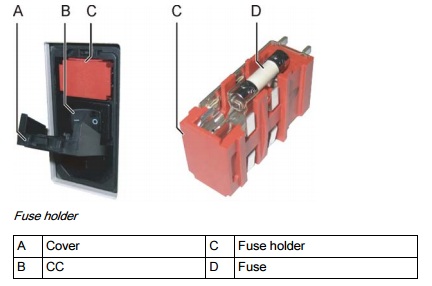
The power plug must be disconnected.
1. Use a screwdriver to carefully pry off the cover of the fuses on the back side of the unit.
2. Pull out the fuse holder.
3. Replace the defective fuses.
4. Reinsert the fuse holder.
5. Close the cover.
Change the filter inserts regularly. Replace both filter inserts once a week or after every forth water change. If a message stating that the water pressure is too low appears, you must change the filter inserts.
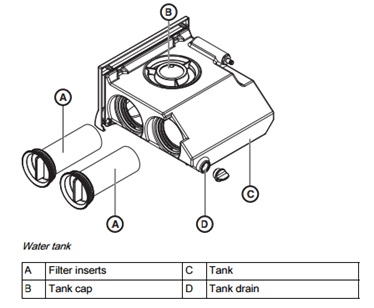
Procedure for all materials except for base metals
Make sure that:
✔ The tank is empty, see below section Removing water from the unit.
Then proceed as follows:
1. Pull out the water tank at the front of the unit.
2. Unscrew the covers on the side and take them out of the tank along with the filter inserts.
3. Rinse the water tank.
4. Insert the new filters with cover into the tank and screw them tight.
5. Fill the tank, see above section Changing the water.
Base metal operation or mixed operation with base metal and other materials
Observe the safety information from the material manufacturer Observe the safety instructions regarding occupational safety and disposal referred to in the material manufacturer's operating instructions. Dirty filters must be disposed of appropriately in accordance with these specifications.
1. Empty the water tank, see above section Emptying the Water Tank
2. Unscrew the covers on the side and take them out of the tank along with the filter inserts.
3. Rinse the water tank.
4. Insert the new filters with cover into the tank and screw them tight.
5. Fill the tank see above section Filling the tank.
Cleaning the plug-in tank
1. Pull out the plug-in tank.
2. Clean the outlet (A) and then rinse it with water.
3. Reinsert the plug-in tank.
Opening the external water tank
Risk of damage to the hoses
If you pull on the hose, you may damage it.
Always pull it from the pipe section (A or B).
1. Pull off the suction connection (A).
2. Pull off the drain hose (B).
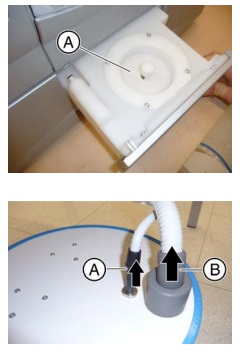
3. Open the clamping ring and lay it down.
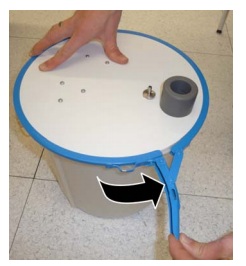
1. Release the filter cartridges by tilting them slightly. The springs remain attached. Tip: If a spring accidentally comes loose, you can reattach it by screwing it in counter-clockwise.
2. Dispose of the filter cartridges with domestic waste.
3. Slowly pour the water out of the container into the outlet so that the ceramic sludge remains in the container.
4. Take the plastic bag out of the container and dispose of it with domestic waste.
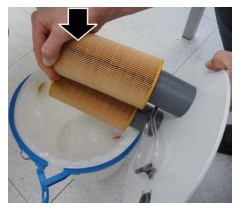
1. Insert the plastic bag into the external water tank in such a way that it protrudes by around 3-4 cm.
2. Ensure that it protrudes evenly around the edge of the container.
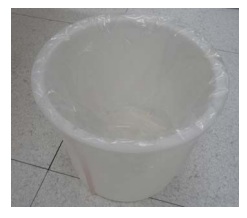
3. Place the clamping ring onto the external water tank with the labelling (A) facing up.
4. Add approx. 400 ml of DENTATEC to the tank.
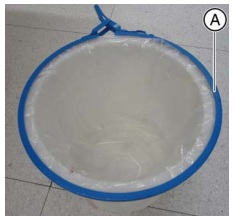
5. Fill the tank up to the filling level with water (approx. 16 litres).
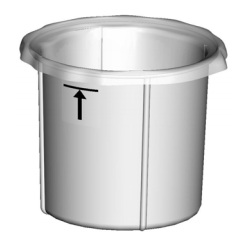
1. Press down the 2 filters until they click into place on the lid.
2. Insert the lid with the filters into the container.
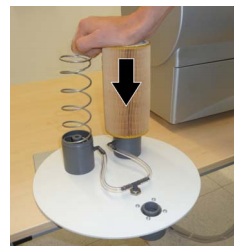
3. Close the clamping ring.
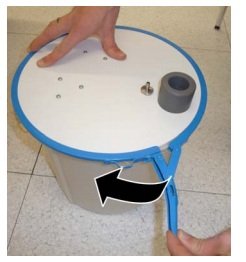
1. Insert the suction connection up to the stop.
2. Insert the drain hose up to the stop.

Risk of overflowing - Sagging of the drain hose may result in overflowing.
Arrange the external water tank in such a way that there is a continuous incline in the drain hose (you may need to rotate or move the external water tank).
You must remove water from the unit if you will not be using it for a long period of time or wish to transport it.
Procedure for all materials except for base metals
Make sure that:
✔ No production process is running.
Then proceed as follows:
1. Switch off the unit.
2. Pull out the water tank at the front of the unit.
3. Drain the water out of the water tank through the drain opening and reinsert the water tank in the unit.
4. Switch the unit on.
5. Pump button active at power-up. The "Pump" button appears on the touch display when the milling unit is switched on. You can start or stop the water pump by pressing this button.
6. Press the "Pump" button to switch the pump on. The water pump then starts pumping the water out of the unit. Let the pump run until no more water escapes from the nozzles.
7. Press the "Pump" button to switch the pump off.
8. Pull out the water tank and empty it.
9. Push it back into the housing.
Base metal operation or mixed operation with base metal and other materials
Observe the safety information from the material manufacturer Observe the safety instructions regarding occupational safety and disposal referred to in the material manufacturer's operating instructions. Dirty filters must be disposed of appropriately in accordance with these specifications.
1. Empty the water tank see above section Emptying the water tank and insert it back into the unit.
2. Switch the unit on.
3. Pump button active at power-up. The "Pump" button appears on the touch display when the milling unit is switched on. You can start or stop the water pump by pressing this button.
4. Press the "Pump" button to switch the pump on. The water pump then starts pumping the water out of the unit. Let the pump run until no more water escapes from the nozzles.
5. Press the "Pump" button to switch the pump off.
6. Pull out the water tank and empty it.
7. Push it back into the housing.
Using the tank cap opener
Risk of damage to the tank
Use the tank cap opener only for opening the tank cap, tank drain and filter insert. Do not use the tank cap opener for closing the tank cap. To close the tank cap, tank drain and filter insert it is sufficient to tighten them clockwise by hand.
Make sure that:
✔ The water tank has been pulled out and drained.
Then place the tank cap opener on the tank cap as shown and take off the tank cap by unscrewing it counter-clockwise.
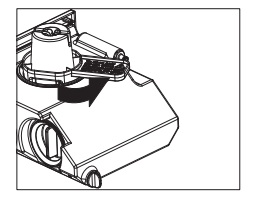
Make sure that:
✔ The water tank has been pulled out and drained.
Then place the tank cap opener on the filter cap as shown, and take off the filter cap by unscrewing it counter-clockwise.
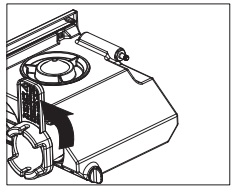
Make sure that:
✔ The water tank has been pulled out.
Then place the tank cap opener on the filter drain as shown, and take off the filter drain by unscrewing it counter-clockwise.
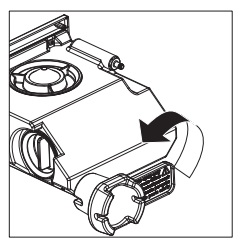
We know an unexpected breakdown in your practice can be a massive headache for you and your patients - which is why we have a dedicated team of 50 people ready to provide you with a range of comprehensive cover options for your practice equipment, giving you complete peace of mind and minimising the cost of an unexpected breakdown. You can depend on us.
With Protection Cover, you get free access to our team of 10 high tech digital support specialists who can help with digital imaging, lasers and CAD/CAM. For the simpler problems, we also have technicians, who are dedicated to helping you over the phone. You can also at a small cost, use their services even if you don't have cover.
Invest in your practice - choose our comprehensive protection cover. For 12 months we will cover the items you want. It includes an annual service, emergency breakdown, labour and access to our high tech digital support specialists.
To get optimum performance from your equipment and to conform to manufacturer’s recommendations, an annual service could be just what you’re looking for. It’s carried out by our accredited team and includes a 3 month warranty on the work.
We are never far away in an emergency. Unplanned breakdowns are a headache for any surgery. We are more than happy to help.
Our equipment team will use the information you provide to respond to your query as promptly as possible.
You could ask about a FREE one-to-one consultation with one of our specialist team, quotation, demonstration of the latest equipment, or any other question you may have in helping you make an informed decision.